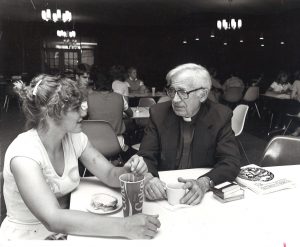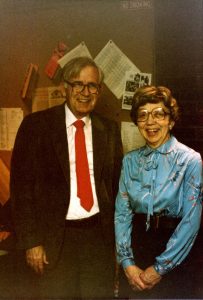748 Valley View Road
Bob and Ruth Esbjornson

Of the professors living on Valley View Road, none endeared himself to Gustavus students more than Bob Esbjornson. “Esby,” as he was known, not only connected with students in class but, as this picture in the old campus Canteen shows, out of class as well. At the old Canteen one could find Esby sitting and talking with students and not at the Faculty Table. And we are not just talking about his connection during the students’ time on the Gustavus campus. For many, his concern for them lasted years after graduation. If a good teacher truly cares not just for what his/her students are learning in the classroom but also outside of class, Esby epitomized that.
In recognition of his love for students, he was presented with the Edgar M. Carlson Award for Innovative Teaching in 1979. Noted in the presentation was a sentence that I found particularly appropriate to describe Esby’s teaching methods: “Lecture notes that have yellowed with age may be found in his files, but never in his briefcase.” Bob was indeed a creative and innovative teacher. I think in his course “Studies in Religion” his most creative teaching took place. It was a class in which many students enrolled. The Carlson award goes on to say, “There is always a fresh approach, a relevant application, a timely treatment.” One of his colleagues wrote “Bob has consistently urged renewal, rethinking, reform, all in the spirit of rejoicing.” Another person wrote ”Everything I have heard about his classroom instruction leads me to conclude that he is challenging, thoughtful, dynamic, sympathetic, and, above all, imaginative in his approach to students and his subject matter. These are the qualities that make an innovative teacher.”
My favorite tribute, though, comes from Elaine Lilly, former student. She told me that “Esby had a way of suspending reality so you could really think.” That was Esby’s greatest quality. He could somehow get you to forget the cares of the day in the classroom so you could focus better on the lesson at hand. If anyone deserved the Edgar M. Carlson Award it was Bob Esbjornson. Hands down.
In addition to his full-time teaching, Esby was involved in many community activities. In 1968, he was the Director of the WCCO Radio Symposium on “Rurbania” which won a national public event award for Gustavus. He was a member of the Board of Directors of the Minnesota Project, an experimental program in urban development and communication. He was a member of the Board of Directors of the Lay School of Theology. I think what he was most proud of, though, was the creation in the late 1960’s of an organization called “The Riverbend Association.” This was a local grass-roots effort to mobilize a host of people from different backgrounds and professions to begin to plan rural land use and city growth on a regional basis. Whereas the newly formed Metropolitan Council based in the Twin Cities was focused on regional planning in the metro area, Riverbend was its counterpart for the region around Mankato, Minnesota. It was so-named because of the bend in the Minnesota River at this location. Riverbend became involved in looking at the future of land use in mining, farming, and city development along with other regional planning issues and Esby was its leader.
Riverbend led to a television series on land use, funded by the Minnesota Humanities Commission and the National Endowment for the Humanities in 1974-75. Bob wrote and directed the programs with the help of the Riverbend group of activists. I always thought that it was one of the first organizations to campaign for and champion a discussion of the often conflicting goals of environmentalists and urban developers. It became a model for other regional planning organizations around the country.
Esby said, “I write every morning. Writing is a part of learning, so you do it every day.” That explains why he wrote a lot of things; worship homilies, television scripts and talks, class lectures, and books. His graduate study thesis was published as A Christian in Politics: Luther W. Youngdahl. He also wrote, “A Procedure for Parish Level Social Action” for The Lutheran Quarterly and “Preaching as Worship” in Worship. His most profound book, though, was the one he wrote about the struggles and ultimate death of his wife Ruth from cancer.
 Ruth was born in Kanistino, Saskatchewan, Canada. She was raised on Staten Island, New York and in Pennsylvania. She was a classmate and roommate of Marian Johnson and graduated from Gustavus in 1941. Maybe she even had her future neighbor Chet, as a teacher. For sure, Marian did become her neighbor. I should add here that the Esbjornsons and Johnsons were life-long friends. I still recall they would have an annual spring picnic with a bottle of May wine by the blooming plum tree in Chet and Marian’s backyard. Here they would sit on a blanket taking in the early spring together. A yearly ritual.
Ruth was born in Kanistino, Saskatchewan, Canada. She was raised on Staten Island, New York and in Pennsylvania. She was a classmate and roommate of Marian Johnson and graduated from Gustavus in 1941. Maybe she even had her future neighbor Chet, as a teacher. For sure, Marian did become her neighbor. I should add here that the Esbjornsons and Johnsons were life-long friends. I still recall they would have an annual spring picnic with a bottle of May wine by the blooming plum tree in Chet and Marian’s backyard. Here they would sit on a blanket taking in the early spring together. A yearly ritual.
After graduation, Ruth taught high school English in Sheffield, Massachusetts. She also worked for an insurance company and, later, as a librarian at Uppsala College in East Orange, New Jersey. At a church service in Holden, Massachusetts, she met a young minister, the Rev. Esbjonson. She and Bob were married in 1945 and lived in Newington, Connecticut, where he was pastor at Holy Trinity Lutheran Church. They moved to St. Peter in 1950 with their two children, Louise and Karl, when Bob started his teaching career at Gustavus. He completed a Master’s Degree in Sacred Theology from Yale Divinity School. As with many faculty spouses, Ruth worked at the college too. She was a librarian for many years until her retirement in 1982. She also was a writer for The Lutheran magazine. Bob edited a collection of her published writings titled Morning and Evening. I’m convinced that she not only proofread manuscripts for Bob’s publications, but also was an “ideas” contributor for many of his writings. He once told me that it was Ruth who was the really “smart one” in the family. I could hardly imagine this, knowing all that Esby had written and been involved in. But behind the scene, or pen as it were, was Ruth. Judy and I thought that she wished she could have been a minister too.
Ruth died on April 3, 1990, a bit too early for that spring ritual under the plum tree with the Johnsons. It was fitting that her Valley View neighbors were her pallbearers: Vic, Doniver, Kyle, Chet, and Floyd.
As I mentioned earlier, Bob chronicled their struggles with Ruth’s cancer in a book called Final Time. For many years, Bob taught a class on medical ethics. He was asked by the college to offer this class, especially for those students who were pre-med. He had to put those tough ethical questions into his own life dealing with Ruth’s illness. Allow me to summarize what Kathryn Christenson, who in her own right is a very fine writer, had to say about the book in the Metro Lutheran magazine, July, 1993. She writes that Bob probes deep questions such as, “Does suffering have meaning? Do medical organizations pay attention to what a patient goes through?”
Bob kept a journal entry every day and these entries comprise the bulk of the book about Ruth’s illness. Here are two of them:
Dec. 21,1989. Ruth and I have entered a new chapter now . . . with the advantage of time to deal with it . . . not letting anticipating what is to come cast a pall over our lives.
April 16, 1990. Much to my surprise . . . Ruth’s death has not separated her from me . . . I do not mean that she appears visually to me or speaks audibly. It is that her perspectives, her practical wisdom, her ideas have merged with mine. It is truly a wonderful experience, even when it evokes sobs from me.
Esby grieved after Ruth’s death. What he did not imagine was the consoling sense of her continuing presence. This is poignant stuff for me. Even in death, as in life, Ruth was Bob’s co-author. He went regularly to her grave to talk to her.
Bob passed away at an assisted living center in St. Peter on October 27, 2007. I’m sure many of his former students likewise still feel his presence.

